牛津初中英语8AUnit5全部教案
- 格式:pdf
- 大小:141.53 KB
- 文档页数:14
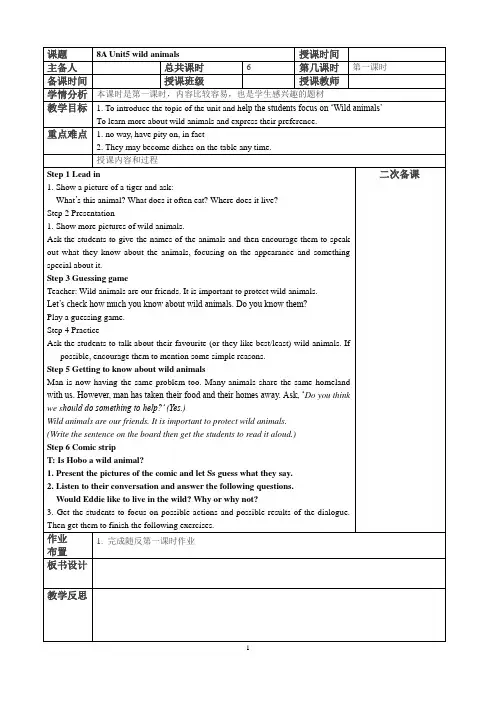
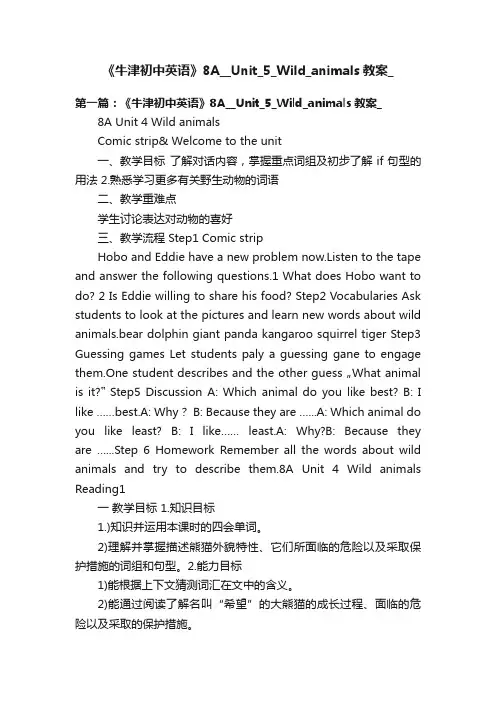
《牛津初中英语》8A__Unit_5_Wild_animals教案_第一篇:《牛津初中英语》8A__Unit_5_Wild_animals教案_ 8A Unit 4 Wild animalsComic strip& Welcome to the unit一、教学目标了解对话内容,掌握重点词组及初步了解if句型的用法 2.熟悉学习更多有关野生动物的词语二、教学重难点学生讨论表达对动物的喜好三、教学流程 Step1 Comic stripHobo and Eddie have a new problem now.Listen to the tape and answer the following questions.1 What does Hobo want to do? 2 Is Eddie willing to share his food? Step2 Vocabularies Ask students to look at the pictures and learn new words about wild animals.bear dolphin giant panda kangaroo squirrel tiger Step3 Guessing games Let students paly a guessing gane to engage them.One student describes and the other guess …What animal is it?‟Step5 Discussion A: Which animal do you like best? B: I like ……best.A: Why?B: Because they are …...A: Which animal do you like least? B: I like…… least.A: Why?B: Because they are …...Step 6 Homework Remember all the words about wild animals and try to describe them.8A Unit 4 Wild animals Reading1一教学目标 1.知识目标1.)知识并运用本课时的四会单词。
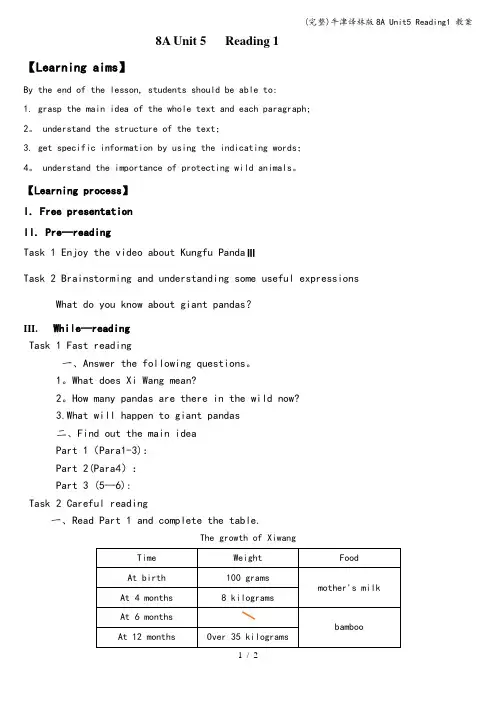
8A Unit 5 Reading 1【Learning aims】By the end of the lesson, students should be able to:1. grasp the main idea of the whole text and each paragraph;2。
understand the structure of the text;3. get specific information by using the indicating words;4。
understand the importance of protecting wild animals。
【Learning process】I. Free presentationII. Pre—readingTask 1 Enjoy the video about Kungfu PandaⅢTask 2 Brainstorming and understanding some useful expressions What do you know about giant pandas?III.While—readingTask 1 Fast reading一、Answer the following questions。
1。
What does Xi Wang mean?2。
How many pandas are there in the wild now?3.What will happen to giant pandas二、Find out the main ideaPart 1(Para1-3):Part 2(Para4):Part 3 (5—6):Task 2 Careful reading一、Read Part 1 and complete the table.The growth of Xiwang二、Suppose you are Xi Wang and say something about yourself三、Read Part 2 and complete the short passage四、Read Part 3 and answer the following questionWhat can we do to save giant pandas?IV。
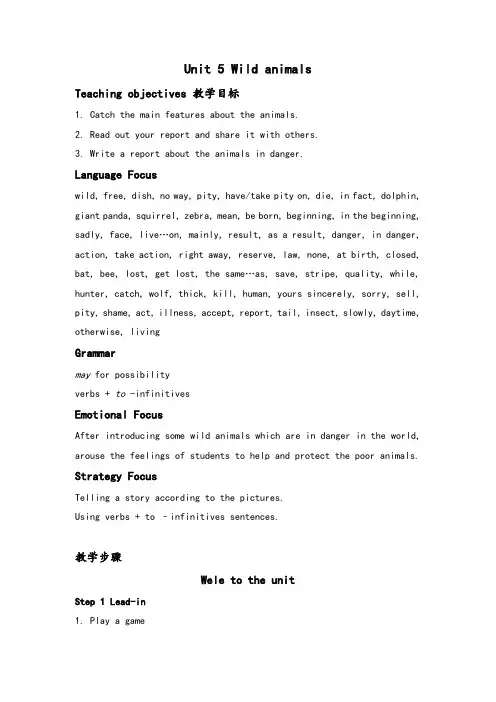
Unit 5 Wild animalsTeaching objectives 教学目标1. Catch the main features about the animals.2. Read out your report and share it with others.3. Write a report about the animals in danger.Language Focuswild, free, dish, no way, pity, have/take pity on, die, in fact, dolphin, giant panda, squirrel, zebra, mean, be born, beginning, in the beginning, sadly, face, live…on, mainly, result, as a result, danger, in danger, action, take action, right away, reserve, law, none, at birth, closed, bat, bee, lost, get lost, the same…as, save, stripe, quality, while, hunter, catch, wolf, thick, kill, human, yours sincerely, sorry, sell, pity, shame, act, illness, accept, report, tail, insect, slowly, daytime, otherwise, livingGrammarmay for possibilityverbs + to -infinitivesEmotional FocusAfter introducing some wild animals which are in danger in the world, arouse the feelings of students to help and protect the poor animals. Strategy FocusTelling a story according to the pictures.Using verbs + to –infinitives sentences.教学步骤Wele to the unitStep 1 Lead-in1. Play a gameGuess the name and features of the animals. What does it look like? What can it do? What does iteat? Where does itlive? What is it?tail---fan swim fish food in the waterlong ears run fast carrots in the hutchcolourfulfeathers sing, learn to saybird food in the cageblack and white climb trees bamboo in the bambooforests2. Look at the pictures. Give the animal names of the pictures. Let someSs give their answers.Step 2 PresentationWork on A.The Wild Animals Club is doing a quiz on wild animals. How much do youknowabout them? Write the correct names under the pictures.Dolphins live __ ___ __________, they can ______ fast. They can play tricksso they are very ______. And they are ________ to people. They eat _____.small, lovely, a long soft tail, red or black furlive in the trees, love climbing treeseat nuts (果仁)black and whitelovelylive in ChinaThey are big. They have brown fur, they can ______ in the water and ______ trees.an African wild horseblack and white stripesbig, strong, yellow fur with black stripes(条纹)run fast, hunt animalseat meatin the wild(野外)Step 3 Work on B.Listen and answer.1. Who likes monkeys best?2. What about Simon?3. Does Peter like pandas best?4. What wild animals does Millie like best?Step 4 ic strip1. Presentation. (flash)2. Listen and fill in the blanks.Would you like to ___ __ ___ ____, Eddie?No.Why not? Wild animals are _____ and ______.I don't think so. They may bee dishes ___ ___ ____ any time. So could you please not eat them?No way!Please ____ ____ ____ them, Eddie.I may die ________ them. __ ____, these are not wild animals, Hobo. Step 5 DiscussionWhat wild animals do you like best? Why?Step 6 ExercisePut the phrases into English.1. 野生动物2. 住在野外3. 任何时候4. 对它们有同情心5. 事实上Step 7 HomeworkWrite a passage about your favourite wild animals.Reading 1Step 1 Warming upDo you know how the baby panda grow up into a giant panda?Let’s look at the pictures about the growth of the panda.Step 2 Fast Reading1. Read and answer.1) Who is Xi Wang? What’s the meaning of Xi Wang?2) What do you think the writer wants us to do?2. Read again and try to make clear about each part.Part 1 (Paras 1--3) the growth of Xi WangPart 2 (Para 4) the problems giant pandas facePart 3 (Paras 5--6) what actions should be taken to protect giant pandasStep 3 Careful Reading1. Millie is making a growth chart for Xi Wang. Help her match the sentences with pictures. Use the information in the report on page 58 to help you. Write the correct letters in the boxes.a She learnt to look after herself.b She was about eight kilograms and started to go outside.c She looked like a white mouse.d She began to eat bamboo.e She weighted 100 grams.f She weighed over 35 kilograms.2. Millie is telling Amy about the serious problems that giant pandas arefacing. plete what she says with the words in the box.as a result in danger in the wildlive on take action very young We need to do something for giant pandas. They’re now _________. For example, giant pandas do not have many babies during their lives, and it’s easy for baby pandas to get sick and die when they’re ___________.Also, giant pandas mainly ___________ a special kind of bamboo, so the bamboo forests are very important to them.However, the bamboo forests are being smaller and smaller. __________, giant pandas may not have a place to live or food to eat. There are now only about 1,600 pandas ___________. We should ___________ to protect them right away.3. Millie’s classmates are asking her some questions about Xi Wang. HelpMillie answer their questions.Kitty: What did Xi Wang eat when she was born?Millie: She ______________________ in the beginning, but half a year later, she began to __________.Simon: Did Xi Wang grow very quickly after she was born?Millie: Yes. She weighed only _________ at birth, but she weighed over _____________ when she was one year old.Sandy: Is it easy for giant pandas to live in the wild?Millie: No, it isn’t. They face ________________.Daniel: So what should we do?Millie: We should help pandas ____________________, build more _______________ and _________ to protect them.Step 4 HomeworkRetell the story.Reading 2Step 1 Language points1. When Xi Wang was born, she weighed just 100 grams.1) was born 出生,出世e.g. She was born in America. 她出生于美国。
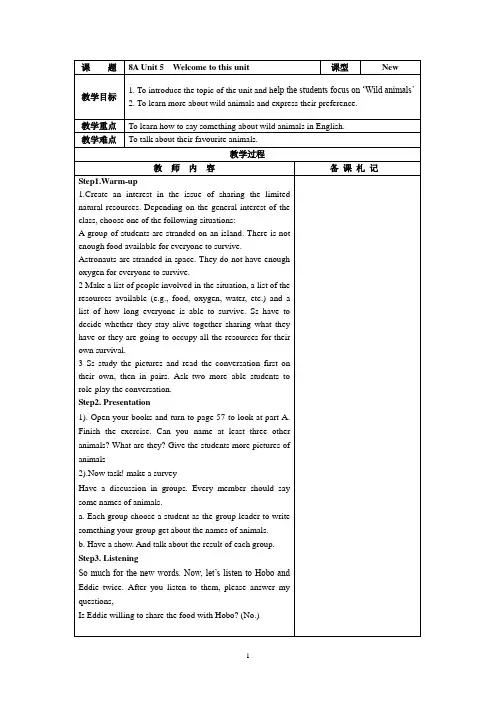
课题8A Unit 5 Welcome to this unit 课型New教学目标1. To introduce the topic of the unit and h elp the students focus on ‘Wild animals’2. To learn more about wild animals and express their preference.教学重点To learn how to say something about wild animals in English.教学难点To talk about their favourite animals.教学过程教师内容备课札记Step1.Warm-up1.Create an interest in the issue of sharing the limitednatural resources. Depending on the general interest of theclass, choose one of the following situations:A group of students are stranded on an island. There is notenough food available for everyone to survive.Astronauts are stranded in space. They do not have enoughoxygen for everyone to survive.2 Make a list of people involved in the situation, a list of theresources available (e.g., food, oxygen, water, etc.) and alist of how long everyone is able to survive. Ss have todecide whether they stay alive together sharing what theyhave or they are going to occupy all the resources for theirown survival.3 Ss study the pictures and read the conversation first ontheir own, then in pairs. Ask two more able students torole-play the conversation.Step2. Presentation1). Open your books and turn to page 57 to look at part A.Finish the exercise. Can you name at least three otheranimals? What are they? Give the students more pictures ofanimals2).Now task! make a surveyHave a discussion in groups. Every member should saysome names of animals.a. Each group choose a student as the group leader to writesomething your group get about the names of animals.b. Have a show. And talk about the result of each group.Step3. ListeningSo much for the new words. Now, let’s listen to Hobo andEddie twice. After you listen to them, please answer myquestions,Is Eddie willing to share the food with Hobo? (No.)Step4. ReadingI want to know Hobo and Eddie better. Please help me. Listen again, then read the article by yourselves. Do some True or False exercises.1).The food is very tasty. (T)2).Hobo can live without food. (F)3).Eddie often takes care of Hobo. (T)4).There is enough food for Hobo and Eddie. (F)Now please pay more attention to these two sentences.If you eat my food, I won’t talk to you.If I don’t have food, I will die.Step5. DescribingIn the story Hobo and Eddie need enough food but there isn’t, so they are poor. The word “poor” can describe an animal, can you find some other words to describe an animal? Now let’s play a game “Bingo”!1).It is very clever. Its favorite food is banana.2).It has a long, soft tail and lives in the trees. It can climb trees quickly.3).It is the biggest animals on land. It can lift heavy things.4).It looks like a large fish in warm sea. You can watch them jump in the zoo.5).It’s like a bear, but it has black and white fur.6).It looks like a cat and has yellow fur and black stripes.7).It’s large and heavy with thick(厚)fur. It is very strong.8).It lives in Australia and it has a long strong tail and has strong legs. There is a useful bag for its babyWrite the animal you like best and like least.Step6 WritingStep7 Homework1.To recite the dialogue.2. Finish the Workbook exercises and the exercise paper.板书设计教学反思课题8A Unit 5 Reading (1) 课型New教学目标1.To develop the ability to guess general meaning form context2.To get to know the problems that the giant pandas are facing and then start to think of way to protect the pandas3.To remember and learn to use the new words.教学重点1.To learn about all the information about giant pandas from the text.2.To get to know the importance of animal protecting教学难点To describe the giant pandas.教学过程教师内容备课札记STEP 1 Lead inGet the students to talk about the animals once again. Playthe guessing game. Write something about a kind of animalon pieces of paper. Invite some of the students to chooseand read about the animal and the others try to guess whatanimal it is.STEP 2 Presentation‘hunter’, ‘survive’ and ‘reserve’As students come to ‘giant pandas’, get the students to talkabout whatever they know about giant pandas. As theymention there are few giant pandas now, teach the words‘hunter’, ‘survive’ and ‘reserve’.To arouse the students’ interest, get the students to guesshow heavy giant pandas are at birth. The teacher can alsogive them some choices to choose from. (e.g. 2 jin, 500grams, 100 grams and 1 kilogram)STEP 3 PracticeTell the students the right answer. (They may be amazed atthe information.)Say ‘I have some pictures here. They show how the babygrows into a giant panda. Can you put them into the rightorder?’Show them the following pictures and ask them to put theminto the right orderSTEP 4 PresentationTell the students, ‘Millie has f ound a report about giantpandas. Let’s read it and learn more about the animal. Butfirst let’s listen to the first part of the passage and answerthe following questions.’Who is Xi Wang? (A baby panda.)How old was Xi Wang when the writer first saw her?(10 days old.)What did Xi Wang look like? (A small white mouse.)What does “Xi Wang” mean in English? (Hope.)STEP 5 Getting to know about XiwangSay ‘So it’s really amazing that the baby panda is so small. Do you want to know how it grows into a giant panda? Let’s open your books and read the passage.’ Get the students to read the passage and fill in the following table.STEP 6 Finishing Part CGet the students to finish Part C: the growth of Xi Wang. Look at the pictures and get the students to read the sentences here loudly. This will once again consolidate the students’ understanding of Xi Wang’s growth.THE GROWTH OF XIW ANG (PARA. 1-PARA.3) AGEWEIGHT FOOD At birth (1 day old) 100 grams (100g) her mother’s milk10 days old like a little white mouse 4 months 10 kilograms (10kg) 8 months 35 kilograms (35kg) Bamboo leaves and shoots12 months / 20 months /TIMEWHAT HAPPENED TO XIW ANG At birth (1 day old) be born4 months Start to go outside her home for the first time 6 months /8 months Grow into a healthy young giant pandas 12 months /20 monthsHave to look after her self板书设计教学反思课题8A Unit 5 Reading (2) 课型New教学目标1.To read the passage once again for more details2.To read the passage again and figure our how the writer organize the passage3.To r ead the passage and focus on the language points to improve the students’ fluency and accuracy talking about giant pandas教学重点To d evelop students’ responsibility towards the endangered anima l教学难点To d evelop students’ responsibility towards the endangered anima l教学过程教师内容备课札记STEP 1 Reading the passage aloud togetherGet the students to read the passage aloud together. Invitethem to finish the Part B, Check the answers. (This mayoffer the less able students another time to consolidate thenew words.)STEP 2 Finishing off Part EAsk the students to finish off Part E, Page 62. Use this as arevision to help the students recall what they have learnedlast time.STEP 3 Working out the answersGet the students to read the passage together once again andthen divide the class into groups of 4-5. Ask them to workout the answer to the following question ‘How many partsare there in the passage.’Give the students enough time to talk about it. And theninvite some of them to express their personal opinions.(Students should be encouraged to speak out what theythink.)Part I: The growth of Xi Wang(Line 1- Line 14) (weight and food)Part II: Giant pandas are in danger?(Line 15- Line 29)A: Why are they in danger?(Line 15-21)B: How to protect them?(Line 22-Line 29)STEP 4 Finishing the following exercisesGet the student to talk about Part I. Invite them to talk aboutthe growth of Xi Wang by finishing the following exercises:•When Xi Wang was born, she w________ just 100 grams.•When she was only 10 days old, she l________ like a white mouse.•When she was 4 months old, she w________ about 10 kilograms and s__•When she was 6 months old, sh e b________ to eat bamboo shoots and leWhen she was 12 months old, she g_________ into a healthy young giant•When she was 20 months old, she s_________ to look afte r herself.Then get the students to analyze the sentences: thewhen-clauses in each sentence give us a past time, so themain clauses use Simple Past Tense. (Students may come tothe conclusion through observation.) Then get the student tounderline such sentences in the passage.STEP 5 Finding them out‘During the growth of Xi Wang, Xi Wang had many ‘first-times’ Can you find them out.’ Use the following exercises to help students.1.She started _________(go) outside her home for the first time.2.She began _________ (eat) bamboo shoots and leaves.3.She started _________(look) after herself.In this way, the teacher directs the students attention to the use of ‘to’-infinitives after ‘start’ and ‘begin’.STEP 6 Rewriting sentencesSay ‘Sadly, it is very difficult for giant pandas to survive in the wild.’ and write the sentence on the board. Then try to rewrite the sentence into the following sentences.‘It is dangerous for giant pandas to live on in the wild.’ ‘They arein danger.’These are some very important sentence patterns in the passage. Also it is necessary for the teacher to point out that ‘live on’ has a similar meaning with ‘survive’. This may also help the students to understand that we can use ‘be dangerous’ or ‘be in danger’ to talk about a similar situation.STEP 7Finding out that why they are in dangerGet the students to find out that why they are in danger. To make the task easier, the teacher can show the following before hand.If hunters ______(catch) a giant panda, they _________ (kill) it for its fu If the farmers ______(cut) down trees and forests, giant pandas _____ (hIf people _____ (find) baby pandas alone, they _____(take)them aw ay. As a result, the students’ attention will be easily drawn to the use of ‘if’-clauses. Guide the students to focus on the tense of the subordinate- clauses and main clauses. (I thinkit is OK for some teachers to use ‘主将从现’ to make summary here. At least it may help the students to remember this phenomenon.)Explain the phrases here ‘kill…for…’, ‘cut down’, ‘haven owhere to live’ ‘find sb. adj’ and ‘take…away’.板书设计教学反思课题8A Unit 5 Grammar 课型New教学目标Using may for possibility Using verbs+to-infinitives教学重点Using may for possibility, Using verbs+to-infinitives教学难点Using may for possibility, Using verbs+to-infinitives教学过程教师内容备课札记Grammar Part AUsing may for possibilitySTEP 1 Presentation1. Review information about reading to lead in grammar A.2. Show the picture of pandas and then the teacher says:It’s difficult for giant pandas to live in the wild. They faceserious problems.What do you think may happen to pandas? Lead students toguess:Ss: they may not have a place to live or food to eat.They may disappear from the earth.Hunters may catch them.Teacher sums up:Yes, you’re right.Write the sentences including may on the blackboard.3. Teacher ask students:What will happen to giant pandas ifwe do nothing?Students answer:Soon there may be none left.write theanswer on the blackboard, mark the underlined part withcolorful chalk and tell students:We use may to say thatsomething is possible.STEP 2 Activities1. Present the following five sentences, encourage studentsto think what may happen in the situation in groups offour. Use may to make the second half of each sentence.Choose some students to report the results, accept anyreasonable answer.(1)We need to protect pandas.(2) It is raining.(3) I will be very busy tomorrow.(4) Watch this DVD.(5) We will be happy to see you.2. Let students complete the exercises in page 61, encouragestudents to ask and answer in pairs. Check the answers.STEP 3 Practice朗读下面的句子,然后译成汉语,并试着说出may的用法。
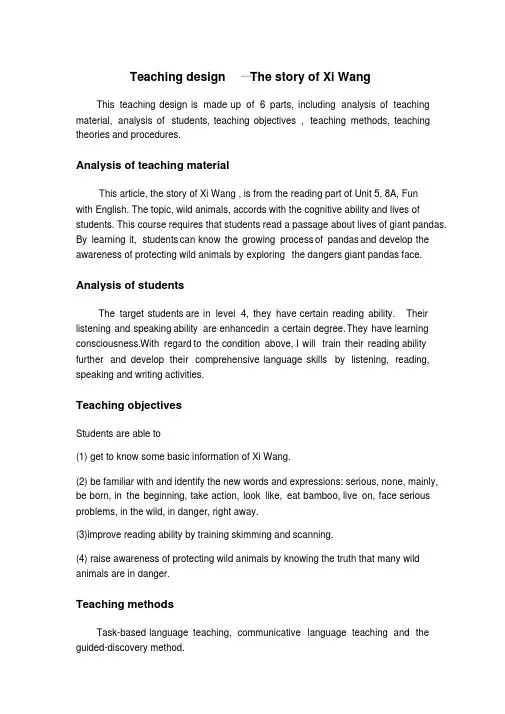
The story of Xi WangTeaching design――This teaching design is made up of 6 parts, including analysis of teaching material, analysis of students, teaching objectives , teaching methods, teaching theories and procedures.Analysis of teaching materialThis article, the story of Xi Wang , is from the reading part of Unit 5, 8A, Funwith English. The topic, wild animals, accords with the cognitive ability and lives of students. This course requires that students read a passage about lives of giant pandas. By learning it, students can know the growing process of pandas and develop the awareness of protecting wild animals by exploring the dangers giant pandas face. Analysis of studentsThe target students are in level 4, they have certain reading ability. Their listening and speaking ability are enhanced i n a certain degree. They have learning consciousness. W ith regard to the condition above, I will train their reading ability further and develop their comprehensive language skills by listening, reading, speaking and writing activities.Teaching objectivesStudents are able to(1) get to know some basic information of Xi Wang.(2) be familiar with and identify the new words and expressions: serious, none, mainly, be born, in the beginning, take action, look like, eat bamboo, live on, face serious problems, in the wild, in danger, right away.(3)improve reading ability by training skimming and scanning.(4) raise awareness of protecting wild animals by knowing the truth that many wild animals are in danger.Teaching methodsTask-based language teaching, communicative language teaching and the guided-discovery method.Teaching theories(1)Make students the real masters of the class and I act as a facilitator.(2)From easy to difficult, from shallow to deep, from simple to complicated.Teaching proceduresIt includes 4 steps: lead-in, pre-reading, while-reading, post-reading.Step 1 Lead-in (have a guess)Firstly, I will present students 3 sentences, they are the description of 3 animals.Then let students guess what animals they are.Secondly, ask students “What’s your favourite animals Why” I will ask some students to share their favourite animals with us.’ interest by a guessing game)(Purpose: To lead in the topic and to arouse studentsStep 2 Pre-readingActivity 1: important words and expressions learning1.In step1, students have shared their favourite animals, so I will ask them: “know what’s my favourite animals” to arouse their interest.Then HaI will also givethem a descriptive sentence to guess what it is――gaint panda.2.Show students a short paragraph of the reason why I like them and some basicinformation of gaint pandas. (These sentences contain important words andexpressions)3.Have students finish B1 to consolidate the words and expressions.(Purpose: To deal with the difficult language points which may impede theunderstanding and to have students be prepared for the reading.)Activity 2: PredictingI’ll ask students “Can you predict the content of the article according to thetitle---The story of Xi Wang”In this process, I’ll encourage students to think andspeak out freely. (Purpose: To enable students to predict before reading and train thestrategy of predicting)Step 3 While-readingListeningI will have students listen the article before reading. Before listening, I will ask them a question “How many pandas are there in the wild”. Have them answer after listening. (To train their ability of listening with questions)Fast-reading (matching)I have divided the article into 4 parts and present the main idea of each part randomly.Have students read the article quickly and do the matching.( To improve ability of skimming)Careful-reading1.Fill-in-table activity. Have students read para1-3, discuss with partners to fill in the table.2.Have students read para4 to find the serious problems giant pandas face.3. Discussion:group workGive students a question “What can we do to protect wild animals” Have them discuss in groups to put forward suggestions.(Purpose: To improve ability of scanning and to enhance their awareness of cooperation in pair and group work)Step 4 Post-reading1.Review: ask one students to lead the whole class to review what they have learned in this lesson.2.World Wildlife Protection DayHomework: have students surf in the internet to look for information of World Wildlife Protection Day. In the next lesson, share the information with the whole class.(Purpose: To train their ability of looking for information and have them aware the importance of wildlife protection in the process of surfing the Internet)。
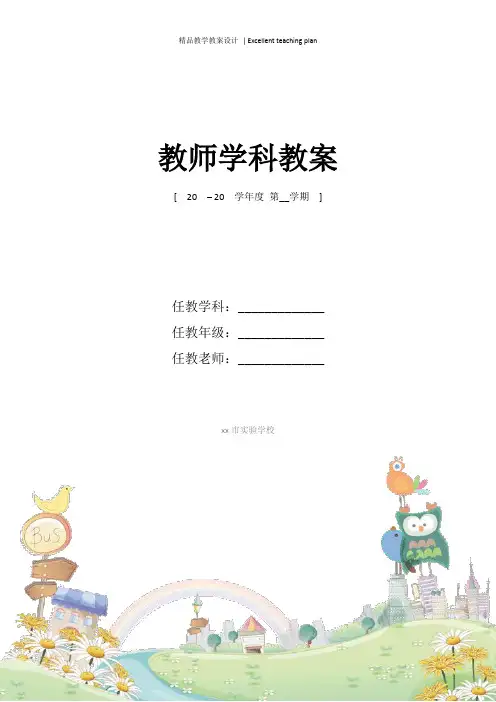
教师学科教案[ 20 – 20 学年度第__学期]任教学科:_____________任教年级:_____________任教老师:_____________xx市实验学校牛津英语8A Unit5 Main task教案一教学内容《Fun With English》译林版8A Unit 5 Main task二教材分析《牛津初中英语》(八年级上)第五单元的话题是“Birdwatchers”,本单元和Unit 4,Unit 6属于一个共同的话题“环境保护”(Unit 4主要谈论“野生动物”,Unit 6主要谈论“自然灾害”)。
牛津教材每个单元十个板块围绕着一个中心话题展开是有序的,从语言学习的终极目标—使用语言来说,前面的对话、阅读等还只是语言的输入部分,真正输出的部分在Main Task 、Integrated Skills和Project几个板块部分。
本单元Main task要求学生会填写申请表格和申请信,语言情景真实,贴近学生生活实际,易于激发学生的学习积极性,同时通过课堂教学在提高学生英语听、说、读的基础上达成写的目标。
三教学目标1.知识目标:理解并运用本课的重点词汇、句型及其用法。
2.能力目标:1)利用所学语言知识,培养听说读写能力--重点是构建写的思路。
2)通过各种教学活动拓展学生的思维能力和英语语言的灵活运用能力。
3)用正确的词汇,句型和结构掌握两种写作文体--申请表和申请信。
3.情感、态度价值观目标:1)拓展相关科普知识、了解动物的生存状况并提出可行的保护措施。
2)通过学写加入观鸟俱乐部的申请表和申请信,增强学生责任感,懂得爱护动物、关爱生命。
四教学重难点1)学会申请表格的英语表达方法。
2)运用所学语言知识描写符合英语语言习惯的申请信。
五课前准备多媒体课件录音机视频展示台申请表六教学过程Step1.Free talkT: What’s your name? May I know your name?T: How old are you? When is your birthday? Do you mean you were born on/in…? Were you born on…?T: Do you live in…? Where do you live? Can you tell me where you live now?T: What’s your telephone number?T: Do you have an E-mail dress? Can you tell me your E-mail address? What’s yourE-mail dress?(设计意图:通过与学生间亲密的问候,拉近师生间的距离,让学生快速地融入英语课堂;通过设计不同层次的问题对学生进行简单信息的了解,自然地复习了本节课中申请信要填写的部分内容。
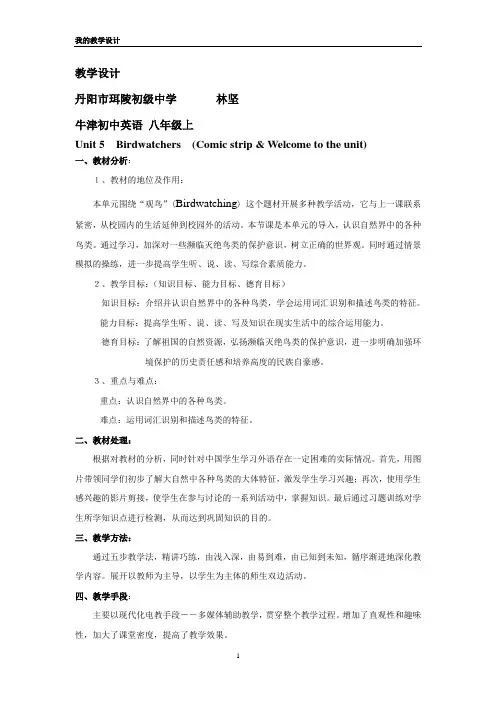
教学设计丹阳市珥陵初级中学林坚牛津初中英语八年级上Unit 5 Birdwatchers (Comic strip & Welcome to the unit)一、教材分析:1、教材的地位及作用:本单元围绕“观鸟”(Birdwatching) 这个题材开展多种教学活动,它与上一课联系紧密,从校园内的生活延伸到校园外的活动。
本节课是本单元的导入,认识自然界中的各种鸟类。
通过学习,加深对一些濒临灭绝鸟类的保护意识,树立正确的世界观。
同时通过情景模拟的操练,进一步提高学生听、说、读、写综合素质能力。
2、教学目标:(知识目标、能力目标、德育目标)知识目标:介绍并认识自然界中的各种鸟类,学会运用词汇识别和描述鸟类的特征。
能力目标:提高学生听、说、读、写及知识在现实生活中的综合运用能力。
德育目标:了解祖国的自然资源,弘扬濒临灭绝鸟类的保护意识,进一步明确加强环境保护的历史责任感和培养高度的民族自豪感。
3、重点与难点:重点:认识自然界中的各种鸟类。
难点:运用词汇识别和描述鸟类的特征。
二、教材处理:根据对教材的分析,同时针对中国学生学习外语存在一定困难的实际情况。
首先,用图片带领同学们初步了解大自然中各种鸟类的大体特征,激发学生学习兴趣;再次,使用学生感兴趣的影片剪接,使学生在参与讨论的一系列活动中,掌握知识。
最后通过习题训练对学生所学知识点进行检测,从而达到巩固知识的目的。
三、教学方法:通过五步教学法,精讲巧练,由浅入深,由易到难,由已知到未知,循序渐进地深化教学内容。
展开以教师为主导,以学生为主体的师生双边活动。
四、教学手段:主要以现代化电教手段--多媒体辅助教学,贯穿整个教学过程。
增加了直观性和趣味性,加大了课堂密度,提高了教学效果。
五、教学程序:一导入通过快速提问,用彩图复习前一单元的相关动物知识,引入本课话题“观鸟”。
二欣赏播放一段影音图像介绍相关鸟类的生活习性。
三呈现播放一些印有该鸟类的图片,请同学们介绍自己对该鸟类的认识。
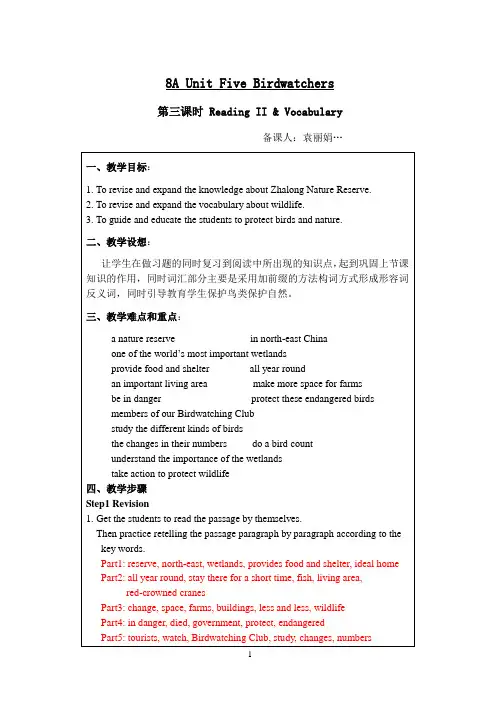
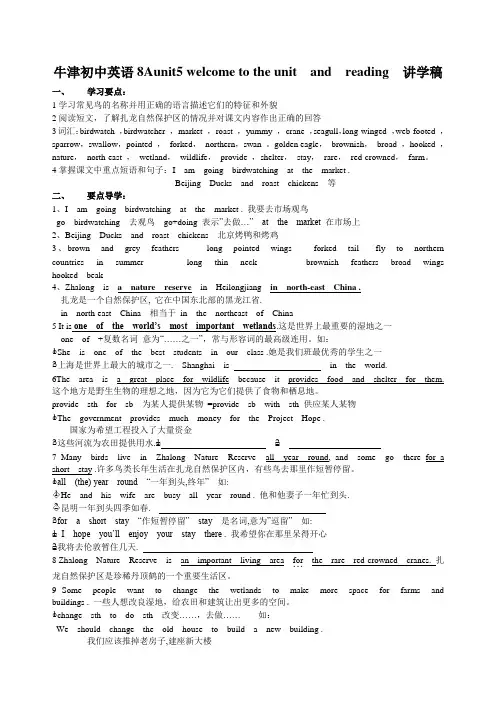
牛津初中英语8Aunit5 welcome to the unit and reading 讲学稿一、学习要点:1学习常见鸟的名称并用正确的语言描述它们的特征和外貌2阅读短文,了解扎龙自然保护区的情况并对课文内容作出正确的回答3词汇:birdwatch ,birdwatcher ,market ,roast ,yummy ,crane ,seagull,long-winged ,web-footed ,sparrow,swallow,pointed ,forked,northern,swan 。
golden eagle,brownish,broad ,hooked ,nature,north-east ,wetland,wildlife,provide ,shelter,stay,rare,red-crowned,farm。
4掌握课文中重点短语和句子:I am going birdwatching at the market .Beijing Ducks and roast chickens 等二、要点导学:1、I am going birdwatching at the market . 我要去市场观鸟go birdwatching 去观鸟go+doing 表示”去做…” at the market 在市场上2、Beijing Ducks and roast chickens 北京烤鸭和烤鸡3、brown and grey feathers long pointed wings forked tail fly to northern countries in summer long thin neck brownish feathers broad wings hooked beak4、Zhalong is a nature reserve in Heilongjiang in north-east China .扎龙是一个自然保护区, 它在中国东北部的黑龙江省.in north-east China 相当于in the northeast of China5 It is one of the world’s most important wetlands.这是世界上最重要的湿地之一one of +复数名词意为“……之一”,常与形容词的最高级连用。
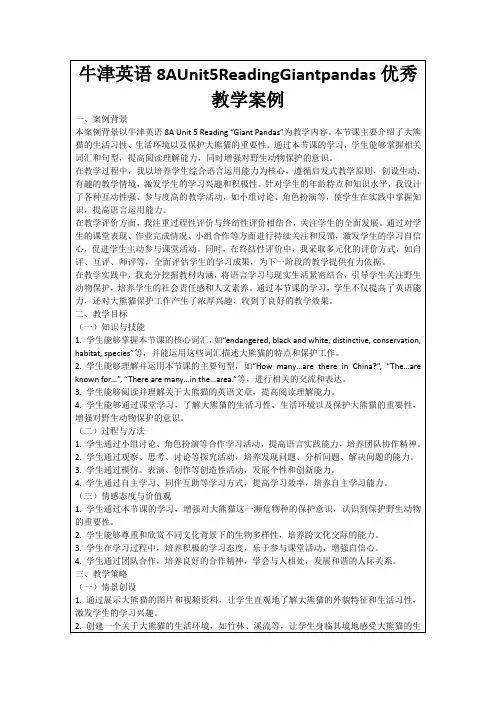
课程篇课题名称8A Unit5Reading教材版本牛津初中英语授课类型新授课授课时间40分钟一、教材分析本课为《牛津初中英语》8A第五单元Reading的教学,计划2课时。
本节课的教学内容为第一课时,让学生从了解一只名叫“希望”的大熊猫的成长过程过渡到对大熊猫现存状况的关注。
文章列出大熊猫面临的诸多危险,唤起学生保护大熊猫的意识。
二、学生分析本节课的教学对象是初二的学生。
经过一年多的学习,他们的英语学习能力有了一定的提高,已经适应了情景交际的模式。
本班学生常参加互帮互助活动以及爱心义卖活动,富有爱心。
但班级学生英语水平差异较大,学困生较多。
因此在教学设计时要兼顾到这些学生,使他们也能体会到上课的乐趣。
三、教学目标1.知识目标(1)掌握四会单词及四会短语。
(2)让学生初步了解大熊猫的生长过程及生存现状。
2.能力目标(1)能灵活运用四会单词及四会短语。
(2)能描述大熊猫的生长过程及生存现状。
(3)通过听磁带能准确找出所需答案。
3.情感目标(1)唤起学生保护大熊猫的意识。
(2)在日常生活中能保护身边的动物。
四、教学重难点听磁带找出准确答案。
五、案例描述首先,我向学生展示一张刚出生的熊猫宝宝的图片让他们猜是什么动物。
我通过这种猜图方式激发学生好奇心。
在告诉学生这是刚出生的熊猫宝宝“希望”之后,又让他们猜“希望”刚出生时多重。
这进一步激发了学生的好奇心。
接着让学生通过听录音分别找出“希望”在出生时、四个月时、八个月时的重量,完成表格。
Months Weightborn100gramsfour10kilogramseight35kilograms(考虑到班级一部分学困生,这张表格的设计比较简单,目的是想让他们不要对听力练习反感,让他们从简单的做起,树立自信心。
在此过程中教授单词weight和weigh,并给出例句加以区分。
)接着我让学生猜大熊猫出生后以什么为食。
大部分学生认为熊猫宝宝以竹笋为食,少部分人觉得熊猫宝宝会喝妈妈的奶。
学员编号:年级:初一课时数:3 学员姓名:辅导科目:英语学科教师:授课类型T-U5 Wild animals C- T-授课日期及时段教学内容(建议2-5分钟)批注:通过以上三幅图片,让学生讲讲自己知道的野生动物或是自己最喜欢的动物,从而进入主题。
(建议20-25分钟)一、词汇Words1. Wild animals are free and happy.wild“野生的”e.g. There are lots of wild flowers on the hill.批注:wild n.“自然环境,野生状态”,[u]in the wildAnimals should live in the wild.2. Please have pity on them, Eddie.句子结构:please祈使句have pity on“同情,怜悯”,pity n.“同情”。
e.g. The old lady often has pity on small animals.批注:What a pity! “真遗憾”3.I may die without them.die v.“死”,dying,dead,deathe.g. Mr. Zhao died two years ago.The doctor tried to save the dying boy.批注:die是不延续性动词,不能和表示一段时间的时间状语连用。
have been dead + for+时间段=died+时间段+agodie of“死于(病,饿,冻)”。
die from“死于(伤,工作或饮食过度)”e.g. The giant panda died of no food.The worker died from a bad wound.4. In fact, these are not wild animals, Hobo.in fact“事实上,实际上”。
牛津初中英语8AUnit5全部教案作者:未知英语教案来源:本站原创点击数:600 更新时间:2008-1-30Unit 5 BirdwatchersWelcome to the unit and Comic stripsTeaching goals:1. To learn common names of birds.2. To revise characteristics and appearance in the context of birds .3. To learn sth funny about Eddie.Focuses:To memorize the names of common birdsDifficulties:To express opinions about birdsStep 1 Introduction1. Write ‘birdwatcher and birdwatching’ on the Bb and elicit Ss’ comments from Ss about what it is. Prompt Ss by asking such questions: What do birdwatchers do? Why? Where?2. Sum up Ss’ answers on the Bb.Step 2 Presentation/ Practice1. T: Now Eddie is going to the market tomorrow. What is he going to do there?Is Eddie a birdwatcher? Why? Show the slides to Ss to arouse their interest.2. Play the tape for Ss to listen and give their answers according to the tape and the pictures.3. Get some pairs to act out the part according to the pictures on the slide show.Step 3 Activating1. T: Lazy Eddie doesn’t know what a birdwatcher does in fact. But now we all know what to do to protect birds. Birds are the spirit of the nature, all of us have the duty to love birds and protect them. You see your friends are coming. Show Ss the pictures of different birds and help them learn their appearance and characteristics together.2. Practice the names and their characteristics together.Step 4 Practice1. Ss describe the birds according to the pictures of each bird, help them at any time.2. Ask pair Ss to make up conversations like this:A:Which bird do you like best?B:I like ________ best.A : Why?B:Because it has__________.Step 5 Production1. Ask more able Ss to describe the appearance and characteristics in front of the class.2. Praise them at any time and encourage more and more Ss to give their opinions bravely.Step 6 Homework1. Go over Reading part after class.2. Practice giving the English for these sentences as written work.1. 丹顶鹤躯体高大,长喙,长脖子,长腿,身披黑色和白色的羽毛。
《牛津初中英语》8A Unit5教学设计课题:Unit 5 Birdwatchers (第一课时).教材分析:第五单元的教学主题是阐述人与自然的关系,以介绍珍稀鸟类及中国扎龙自然保护区为教学中心话题。
动物是初中学生日常生活中的伙伴,也是一些同学的宠物。
鸟类作为自然界的精灵,很受学生们的喜欢,对珍稀鸟类的学习能够唤起学生的知识储备,也较容易聚集学生学习的兴趣和动力,这些都有利于教学活动的开展。
设计的背景和定位:班级的人数为50人,平时课堂纪律良好,大多数学生对英语课感兴趣,学习成绩和学习能力为正态分布。
学生的学习欲望强烈,思维活跃。
时间为45分钟的单节课。
教学方法:通过任务型语言教学法,由浅入深,由易到难,由已知到未知,循序渐进地深化教学内容。
展开以教师为主导,以学生为主体的师生双边活动。
教学相关资源:教师参考书:1、《牛津初中英语——8A》教师教学用书,译林出版社;2、《怎样学好牛津英语8A》(八年级第一学期),上海教育出版社。
准备设施:录音机,多媒体,投影仪教学目标:知识目标1.基础较好的学生能对新授词汇达到认读、拼写和正确运用的要求。
基础较弱的学生力求达到认读、了解的要求。
2.通过对Comic strip的学习,初步了解运用一般现在时讨论将来的事。
能力目标1.能运用所学的词汇来描述各种鸟类的外形特征。
2.能正确运用不同句型来表达自己对鸟类的喜好及原因。
情感目标通过对自然界鸟类的了解来关注人与自然的关系,养成正确对待自然界生灵的生活态度。
教学重点与难点:1.有关鸟类外形特征词汇的学习与掌握。
2.怎样描述不同的鸟类外形特征。
本课我以素质教育为目的,结合教材重点、难点及英语学科特点,利用多媒体辅助教学,从视、听、说等方面使学生得到锻炼,在愉快、轻松的氛围中温故而知新。
兴趣是最好的老师。
在本课教学设计过程中,我始终注意激发学生学习英语的兴趣,保持他们的注意力,顺利地完成了新知识的学习。
最后就是,学习英语,或学习任何科目,都是师生合作的过程。
牛津初中英语8AUnit5全部教案作者:未知英语教案来源:本站原创点击数:600更新时间:2008-1-30Unit5BirdwatchersWelcome to the unit and Comic stripsTeaching goals:1.To learn common names of birds.2.To revise characteristics and appearance in the context of birds.3.To learn sth funny about Eddie.Focuses:To memorize the names of common birdsDifficulties:To express opinions about birdsStep1Introduction1.Write‘birdwatcher and birdwatching’on the Bb and elicit Ss’comments from Ss about what it is. Prompt Ss by asking such questions:What do birdwatchers do?Why?Where?2.Sum up Ss’answers on the Bb.Step2Presentation/Practice1.T:Now Eddie is going to the market tomorrow.What is he going to do there?Is Eddie a birdwatcher?Why?Show the slides to Ss to arouse their interest.2.Play the tape for Ss to listen and give their answers according to the tape and the pictures.3.Get some pairs to act out the part according to the pictures on the slide show.Step3Activating1.T:Lazy Eddie doesn’t know what a birdwatcher does in fact.But now we all know what to do to protect birds.Birds are the spirit of the nature,all of us have the duty to love birds and protect them. You see your friends are coming.Show Ss the pictures of different birds and help them learn their appearance and characteristics together.2.Practice the names and their characteristics together.Step4Practice1.Ss describe the birds according to the pictures of each bird,help them at any time.2.Ask pair Ss to make up conversations like this:A:Which bird do you like best?B:I like________best.A:Why?B:Because it has__________.Step5Production1.Ask more able Ss to describe the appearance and characteristics in front of the class.2.Praise them at any time and encourage more and more Ss to give their opinions bravely.Step6Homework1.Go over Reading part after class.2.Practice giving the English for these sentences as written work.1.丹顶鹤躯体高大,长喙,长脖子,长腿,身披黑色和白色的羽毛。
2.海鸥翅膀长,蹼足,长着灰白色和黑色的羽毛。
3.麻雀身材娇小,短喙,长有褐色和灰白色的羽毛。
4.燕子翅膀又长又尖,叉状尾巴,身披黑色和白色的羽毛。
5.天鹅长有黄色的喙,脖颈细长,身披洁白的羽毛。
6.金雕长着钩状的喙,翅膀宽大,长有带棕色的羽毛。
Reading(I)Teaching goals:1.To infer general meaning from title and context.2.To check understanding by evaluating sentences3.To skim text for overall meaning and scan for detailsFocuses:To revise and expand vocabulary in the context of wildlife and conversationDifficulties:To infer the meaning of words from the contextStep1Presentation1.T:Do you know where birdwatchers watch birds?Elicit Ss’answers on he Bb:in the country parks; special nature reserves.2.Write the title:Zhalong---A special Place on the Bb.Ask Ss what they know about Zhalong. Encourage any contributions.3.Conclude this on Bb:birds come to Zhalong are water birds.They live on wetlands to feed,breed or rest for all or part of their life cycle.Some swim under the water to get food;Some feed at the edge of water and on land;and others find food in the vegetation in the wetlands.Many species of water birds are migratory.They breed in one wetland area and fly to a different one to spend the cold months.They sometimes interrupt their journey and stop at other wetlands to rest and feed.4.Ask pair Ss to exchange their information and opinions about the different materials they are studying.Step2Reading1.Ss skim the text quickly,focusing on the keywords and main points only.2.Pair Ss ask and answer the questions in class and check together.(1)What birds come to Zhalong?(2)Why is zhalong a special space?(3)Do birds live in Zhalong all year round?(4)What does Chinese government want to do?(5)What do people should do for birds?(6)What do you think about after listening to the tape?Step3Reading1.Ask Ss to write a caption for each paragraph.Elicit quick feedback from the class on the correctallocation of captions by asking Ss to read out the captions in the correct sequence.(1)Zhalong is an ideal home of a lot of plants,fish and birds.(2)Natural homes for red-crowned cranes.(3)Don't use wetlands as farms and buildings.(4)More and more birds are in danger.(5)Making records of birds in Zhalong.(6)Zhalong needs help.2.Play the tape for Ss to follow twice with books open,the play the tape again for Ss to repeat with books closed.Step4Consolidation1.Ss read the text freely for true or false questions.(page79Part C1)(1)Zhalong is a nature reserve in China.()(2)Birds can find food easily in Zhalong.()(3)Some birds go to Zhalong for a short stay.()(4)The birds in Zhalong live in large cages.()(5)There are lots of red-crowned cranes in other parts of the world.()(6)Many endangered birds live in Zhalong now.()(7)Zhalong needs more people to feed birds.()(8)Studying zhalong helps us to learn about protecting wildlife.()2.Ss practice the sentences together.Check answers as a whole class.3.Give the English for the sentences.(page79Part C2)(1)观鸟俱乐部需要人们来为鸟类做点事情。